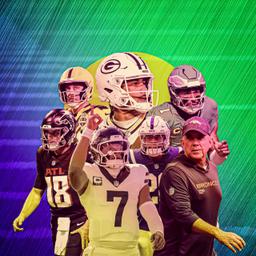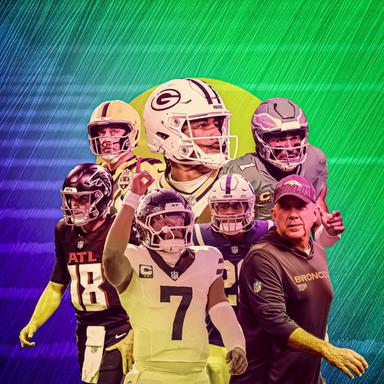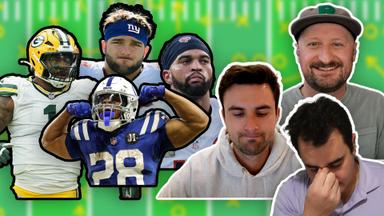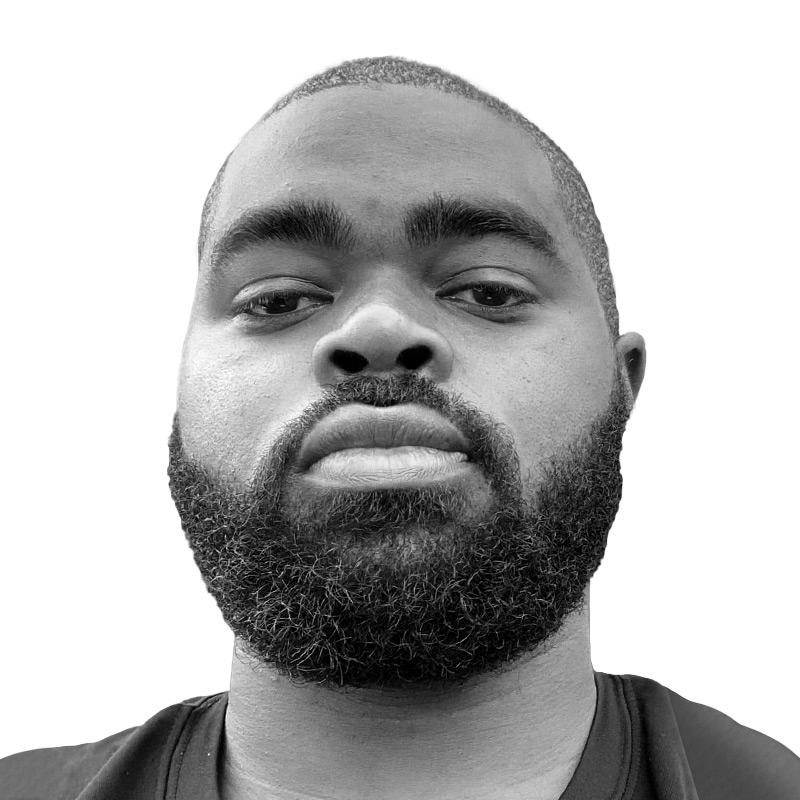As we approach the midway point of the 2025 NFL season, it's time to recognize some of the early difference makers from the most recent draft.
The first few rounds of the 2025 NFL draft were all about players in the trenches, so it’s no surprise that after eight weeks of action, some of the best rookie performances have come from offensive and defensive linemen. The season has been light on breakout stars in the skill position spots, but several rookie tight ends, linebackers, and safeties have had a great start—which is notable because of the time it typically takes to develop the versatility demanded by each of those roles.
This list is constructed like an All-Pro team roster, but I’m not just looking at who has the best raw production—I also considered how well each player has settled into their specific roles and the schemes their teams are running. This is The Ringer’s midseason All-Rookie team.
Quarterback
Jaxson Dart, New York Giants
I have no problem admitting that I was totally wrong about how Dart would look in his first few starts with the Giants. He’s shown that he can make winning plays by creating offense out of structure, something that I thought would overwhelm him early in his career. But he’s been an effective (albeit reckless) scrambler when plays break down, he’s thrown with accuracy on the perimeter, and he’s been willing to push the ball downfield.
So far, Dart’s rookie year has reminded me of Carson Wentz’s with the Eagles in 2016. While Dart doesn’t have the same raw arm talent that Wentz did back then, he’s got similar self-belief, bordering on arrogance. Dart has a tendency to hold on to the ball, looking for a way to escape or make the play, and as a result, he has taken a beating in the pocket. He’s being blitzed at the sixth-highest rate in the league, and he’s being either hit or sacked on 17 percent of his dropbacks, which ranks 26th. He’s also turnover prone when under pressure, with three interceptions and a lost fumble in his five starts.
As the season goes on, we’ll see whether he’s able to adapt his style of play into something a bit more stable, because what he’s doing so far can’t be sustained over the long term. By tamping down on the silly mistakes, Dart could be a serviceable quarterback for New York for the next few seasons.
Honorable mention: Cam Ward, Tennessee Titans
Running Back
Quinshon Judkins, Cleveland Browns
Judkins missed all of Cleveland’s offseason workouts and training camp while awaiting resolution of a legal issue following his arrest in July on domestic violence charges. In early September, prosecutors in Ohio declined to file formal charges. Since taking the field, Judkins has outpaced his peers in production. He leads all rookies in rushing yards and is tied for the lead in touchdowns. Judkins has been a tough runner between the tackles and has been the best rookie so far at finding extra yards after contact.
While Judkins is the pick here at the midseason point, there have been several surprises at running back this year—both good and bad. Raiders rookie Ashton Jeanty was supposed to be the engine of Las Vegas’s offense, but the supporting cast around him hasn’t given him the help he needs to create a consistent rhythm or explosive opportunities on his carries. Two rookie running backs in the NFC East, Cam Skattebo and Jacory Croskey-Merritt, have been closer to the type of back that Jeanty was supposed to be early in his career. Skattebo’s versatility as a runner and receiver made him a seamless fit in New York’s offense before he suffered a season-ending ankle injury in Week 8, and Croskey-Merritt has been great at making defenders miss and generating explosive runs on the perimeter.
I still think that Jeanty can be a star (and some of his recent performances have been encouraging), but his early struggles and the success of other rookies are a reminder of how dependent running back play is on factors beyond an individual’s talent.
Honorable mentions: Ashton Jeanty, Las Vegas Raiders; Cam Skattebo, New York Giants; Jacory Croskey-Merritt, Washington Commanders
Wide Receiver
Emeka Egbuka, Tampa Bay Buccaneers; Tetairoa McMillan, Carolina Panthers; Travis Hunter, Jacksonville Jaguars
I was skeptical about several first-round receivers in this class, none more so than Egbuka. All I saw in Egbuka when he was coming out of Ohio State was a bigger slot receiver with dependable hands, and I expected him to struggle to separate from defensive backs once he got to the next level. I still think that the critiques that I had about his speed were fair, but now that he’s in the NFL, he’s proved to be an excellent route runner who understands the nuances of how to get open—and how to catch the ball in traffic when he’s well covered.
Through eight weeks, he’s been the most productive rookie wide receiver, getting 562 yards and five touchdowns, and his playmaking has been a driving force behind quarterback Baker Mayfield’s MVP campaign.
Egbuka reminds me of Robert Woods; both consistently play bigger and faster than their measured size and 40-yard dash time. Egbuka will be one of the league’s most valuable players if he can maintain his current level of play.
Elsewhere in the NFC South, Panthers receiver McMillan has lived up to the hype as a legitimate outside receiver. He’s been asked to beat single coverage on the perimeter more often than any other rookie, and only Egbuka has outgained him against man coverage.
Jaguars receiver Hunter lands in our third spot, but it’d be dishonest not to acknowledge that the season has been a bit of a dud so far for the 2024 Heisman Trophy winner. There are times when Hunter gets a quick pass thrown his way and is able to create in space (and his athletic traits pop in those instances), but the Jags haven’t truly fleshed out a role for him in the offense yet. His 298 yards are third among rookie receivers, but I think it's fair to want a more expanded set of opportunities for Hunter going forward.
Honorable mentions: Matthew Golden, Green Bay Packers; Elic Ayomanor, Tennessee Titans
Tight End
Tyler Warren, Indianapolis Colts
Draft analysts (including me) sometimes need reminders that specific weaknesses in technique don’t always outweigh a player’s athletic gifts. That’s the case with Warren. He might not be the greatest blocker or sharpest route runner (yet), but the Colts drafted him in the first round because he forces mismatches in the passing game—something he’s done to great effect in Indianapolis.
Warren leads all tight ends in receiving yards with 492—and he’s averaging 2.21 yards per route for the scorching Colts offense so far this season. Head coach Shane Steichen is scheming ways to get the rookie open by using misdirection and play-action, and Warren is attacking voids in zone coverage. It's reasonable to think that he can become one of the league’s best playmakers as he develops a more traditional tight end skill set.
Honorable mentions: Oronde Gadsden II, Los Angeles Chargers; Harold Fannin Jr., Cleveland Browns
Offensive Tackle
Armand Membou, New York Jets; Will Campbell, New England
Guard
Tyler Booker, Dallas Cowboys; Grey Zabel, Seattle Seahawks
Center
Jonah Monheim, Jacksonville Jaguars
The first few rounds of the 2025 draft were flush with offensive line talent, and we’ve already seen several rookies flash Pro Bowl potential. We often see great athletes come into the league, but what I appreciate most about this class is its high football IQ. There are seldom moments when the players on this All-Rookie squad totally blow their assignments or fail to execute their teams’ blocking schemes.
My favorite rookie lineman to watch has been Booker, who has the power and technique in the run game to move just about any defensive tackle. There were predraft questions about whether he’d have the quickness to handle fast defenders at the pro level or win individual matchups in pass protection. But he’s been effective in both facets for Dallas thus far, and he’s a major contributor to one of the league’s most exciting offenses.
The biggest takeaway from this rookie class is that these players are succeeding with varying styles of play. Membou and Campbell are totally different archetypes—Membou is more powerful, Campbell is more agile—but both have been major assets for their respective teams. So has Saints tackle Kelvin Banks, an honorable mention here. He was considered by several teams to be a better fit at guard because he lacked top-end athletic traits, but he’s proving that he can hold his own at his preferred position.
Zabel’s had a quietly excellent season in his own right, and he’s maybe the only dependable blocker Seattle’s had in the run game this season. (Monheim has been the only rookie playing at center, so he gets the nod here by default, even though he’s had an up-and-down campaign for the inconsistent Jaguars.)
If this year’s strong rookie class of offensive linemen is the beginning of a trend, the quality of offenses around the league will take a big step forward in the years to come.
Honorable mentions: Kelvin Banks Jr., New Orleans Saints; Jared Wilson; New England Patriots; Tate Ratledge, Detroit Lions
Defensive Tackle
Mason Graham, Cleveland Browns; Deone Walker, Buffalo Bills
Evaluating rookie defensive linemen is always tricky because their production rarely shows up on the stat sheet. Instead, we need to look closely at the film.
The box scores would tell you that Graham, the fifth overall pick, has been a disappointment. Graham has had only a half sack and two tackles for loss through his first eight games, but his presence on this defense has been essential. When you turn on the film from Cleveland’s games against Green Bay, Minnesota, and Miami this season, you can see that there was no room to run between the tackles. That’s a credit to Graham’s technical skill and how well he executes his assignment within Jim Schwartz’s scheme. The questions about his ceiling are legitimate because he isn’t the most physically imposing defensive tackle. But what we’ve seen so far is confirmation of what we knew about him when he was in college at Michigan—having him on the field instantly makes a run defense better.
Walker gets the nod at the second interior spot here because of his seven tackles for loss through seven games. His film, though, can be frustrating to watch, just like his college film before the draft. When Walker was at Kentucky, he looked like a human wall, with the burst and strength to dominate up front whenever he wanted, but he struggled with technique and consistency. That’s been his issue in Buffalo so far. A handful of exciting plays are surrounded by examples of poor execution and focus, and that’s something Buffalo needs to correct if Walker wants to take the next step forward in the second half of the season.
Honorable mentions: Kenneth Grant, Miami Dolphins; Jamaree Caldwell, Los Angeles Chargers; Derrick Harmon, Pittsburgh Steelers
Edge Rusher
Abdul Carter, New York Giants; Mykel Williams, San Francisco 49ers
When an edge rusher just has it, you can see it clearly on film. Carter is that guy right now, and the rest of the NFC East should be concerned that he will be chasing quarterbacks in this division for a long time. Carter hasn’t had a true breakout game in terms of sacks yet, but he leads all rookies in pressures (by a considerable margin), even as he’s learning on the fly. He’s been using his hands more often as a pass rusher, trying to create countermoves while setting edges in the run game. The Giants will play several teams with good offensive tackles this season, so let’s be patient with Carter’s raw production. But let’s be clear: He is a star in the making.
The loss of star teammate Nick Bosa has put Williams in a tough position. Without a premier rusher playing on the opposite side on every down, Williams is drawing more attention from offenses, and that’s affecting his production. As a run defender, though, he’s the best among all the rookies at his position, setting edges with force, controlling blockers with great technique, and racking up four tackles for loss through eight weeks. San Francisco has been moving Williams around on obvious passing downs to get him more one-on-one rushing opportunities, and that should help jump-start his pass rushing production in the second half of the season.
Honorable mentions: Donovan Ezeiruaku, Dallas Cowboys; James Pearce Jr., Atlanta Falcons
Inside Linebacker
Jihaad Campbell, Philadelphia Eagles; Carson Schwesinger, Cleveland Browns
In the modern NFL, you’re more likely to notice linebackers because of the mistakes they make rather than the opportunities they create. This is especially true for younger players. The 2025 class has broken that mold, led by Campbell and Schwesinger.
These were the first two off-ball linebackers taken in the draft, and both have had surprising starts to their NFL careers relative to their predraft scouting reports. I had expected Campbell to be more of a downhill thumper type of linebacker, someone much more comfortable playing in the offense’s backfield than dropping back in coverage. In Philadelphia, he’s been more valuable in pass coverage, matching up with tight ends and taking away throwing lanes in the middle of the field.
Schwesinger, meanwhile, struck me as more of a sideline-to-sideline type of linebacker, with range in zone coverage and better feel out in space. Cleveland has used him as a thumper instead, with his best plays coming as a downhill run defender. That both players have succeeded early on is a credit to them individually but is also a reflection of how much influence their respective coaching staffs have had on their development. I would not be surprised if both become Pro Bowl–caliber players early on in their careers.
Honorable mentions: Shemar James, Dallas Cowboys; Demetrius Knight Jr., Cincinnati Bengals
Cornerback
Will Johnson, Arizona Cardinals; Trey Amos, Washington Commanders; Upton Stout, San Francisco 49ers
Johnson was one of my favorite prospects in the 2025 draft class. Had there not been questions about his health last spring, he probably would have gone in the first round. But there’s no question that he’s playing like a first-rounder now. Whether he’s been in press or off coverage, he’s done a good job of breaking on routes and competing at the catch point, with five pass breakups in his five games. Arizona’s defensive backfield has been a bit of a disappointment this year, but Johnson’s been a bright spot.
Amos has been a big addition for the Commanders defense, and that unit’s overall issues in coverage have overshadowed just how well he has been playing. Amos came into the league as more of a man coverage corner who was comfortable playing in press coverage—and Washington’s been allowing him to play one-on-one against opposing receivers. Amos’s length and physicality will be a huge help in Washington’s divisional games, where he’ll have to match up with the likes of Eagles receiver A.J. Brown and Cowboys receiver George Pickens.
Honorable mention: Jacob Parrish, Tampa Bay Buccaneers
Safety
Nick Emmanwori, Seattle Seahawks; Xavier Watts, Atlanta Falcons
This year’s safety class has been one of the best surprises of the season so far. There were concerns that the rookies at that position didn’t have the raw athleticism to match up in man coverage or the football IQ to play in zone coverage—and both preconceptions have been proved wrong.
Seahawks hybrid defender Emmanwori was supposed to be a much better blitzer and tackler than coverage player early on in his career, but he’s been a key piece in Seattle’s excellent pass defense this season. A lofty comparison can be made between him and Ravens safety Kyle Hamilton, and his impact as a slot defender suggests that he may be able to fill that type of role for Seattle over the long term.
The second safety spot goes to Falcons rookie Watts, but it just as easily could’ve gone to his teammate Billy Bowman. Ultimately, I went with Watts because Bowman spends more of his time in the slot than in a traditional safety alignment. Both flashed excellent ball-tracking skills on their two combined interceptions, both have played with great instincts in coverage, and both show up as tacklers in the run game. Atlanta’s defensive success has been a major surprise in 2025, and having these safeties blanketing receivers in coverage is a big reason why it's happening.
Honorable mentions: Billy Bowman, Atlanta Falcons; Malaki Starks, Baltimore Ravens






